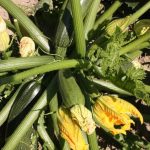Are you looking to enhance the health and productivity of your vegetable garden? One way to achieve this is by incorporating bone meal into your gardening routine. Bone meal serves as a natural and beneficial fertilizer for vegetable plants, providing essential nutrients that promote their growth and overall well-being.
Derived from ground animal bones, bone meal is rich in important nutrients such as phosphorus and calcium, which are crucial for the development of strong roots and healthy plant growth. This organic fertilizer is an excellent addition to any vegetable garden, contributing to the overall vitality of the plants and the quality of the produce.
In this article, we will explore the benefits of using bone meal in vegetable gardens, including its nutrient content and how it promotes healthy root development. We will also provide a step-by-step guide on how to effectively incorporate bone meal into the soil, along with tips for proper application to different types of vegetable plants.
Additionally, we will address common misconceptions about bone meal and share real-life success stories of its impact on vegetable gardens. Whether you are a beginner or experienced gardener, understanding the role of bone meal in vegetable gardens can elevate your gardening practices and yield fruitful results.
Benefits of Using Bone Meal in Vegetable Gardens
Bone meal is a natural fertilizer that provides several key nutrients essential for the healthy growth of vegetable plants. It is rich in phosphorus, which plays a crucial role in promoting strong root development and overall plant vitality. Additionally, bone meal contains calcium, which helps prevent common deficiencies in vegetable crops such as blossom end rot in tomatoes and peppers.
Phosphorus is important for seedling development and early root growth. When vegetable plants receive an adequate supply of phosphorus from bone meal, they are better equipped to establish strong root systems, which ultimately leads to improved water and nutrient uptake. This results in healthier, more resilient plants that are better able to withstand environmental stressors and produce higher yields.
In addition to phosphorus and calcium, bone meal also contains small amounts of nitrogen and other trace minerals that contribute to overall plant health. These combined benefits make bone meal an excellent choice for organic gardeners looking to support the long-term success of their vegetable gardens while minimizing their environmental impact.
| Nutrient | Benefit |
|---|---|
| Phosphorus | Promotes strong root development and early growth |
| Calcium | Prevents common deficiencies such as blossom end rot |
| Nitrogen | Supports overall plant growth and vigor |
How to Use Bone Meal in Vegetable Gardens
Bone meal is a valuable natural fertilizer that can provide numerous benefits for vegetable gardens. When it comes to using bone meal in vegetable gardens, it’s essential to know the proper methods for incorporating this organic fertilizer into the soil. Below is a step-by-step guide on how to effectively use bone meal in your vegetable garden:
- Prepare the soil: Before adding bone meal to your vegetable garden, ensure that the soil is adequately prepared. This may include removing any weeds, loosening the soil, and adding compost or other organic matter.
- Calculate the appropriate amount: It’s important to determine the right amount of bone meal to use for your specific vegetable plants. A general guideline is to apply around 1-3 pounds of bone meal per 100 square feet of garden area.
- Incorporate into the soil: Once you have calculated the necessary amount, evenly distribute the bone meal over the soil surface and gently work it into the top layer using a rake or gardening fork. Be sure to mix it thoroughly with the soil for optimal results.
Proper application of bone meal is crucial for ensuring maximum nutrient uptake by vegetable plants and promoting healthy growth. Here are some additional tips to keep in mind when using bone meal in your vegetable garden:
- Water thoroughly after application: After incorporating bone meal into the soil, water your vegetable garden thoroughly. This will help activate the nutrients in the bone meal and facilitate their absorption by plant roots.
- Reapply as needed: Depending on the specific needs of your vegetable plants and the nutrient content of your soil, you may need to reapply bone meal throughout the growing season. Regular soil testing can help determine when additional applications are necessary.
- Avoid direct contact with plant roots: When applying bone meal, be mindful not to place it directly in contact with plant roots as this can cause burn injury. Instead, ensure that it is mixed uniformly into the surrounding soil.
By following these guidelines and best practices for using bone meal in vegetable gardens, you can optimize its benefits and contribute to the overall health and productivity of your vegetable crops.
Best Practices for Using Bone Meal
When utilizing bone meal in vegetable gardens, it is essential to follow best practices to ensure the effective and safe application of this organic fertilizer. By understanding the ideal timing for applying bone meal and addressing potential challenges, gardeners can maximize its benefits while avoiding any negative impacts on their plants.
Here are some best practices to consider when using bone meal in your vegetable garden:
- Timing: It is recommended to incorporate bone meal into the soil before planting or during the initial stages of growth. This allows the nutrients from the bone meal to be readily available to the plants as they establish their root systems.
- Application: When applying bone meal, it is important to follow the recommended dosage based on the type of vegetable plants being grown. Over-application of bone meal can lead to an excess of certain nutrients, potentially causing harm to the plants.
- Mixing: To ensure even distribution of nutrients, thoroughly mix bone meal into the top layer of soil around each plant. This will help promote healthy root development and overall plant growth.
While using bone meal in vegetable gardens offers numerous benefits, there are certain precautions that should be taken into consideration:
- Potential Risks: Excessive use of bone meal can lead to an imbalance of nutrients in the soil, which may negatively affect plant health. To avoid this, it is important to follow dosage recommendations and monitor plant responses closely.
- Environmental Impact: When using bone meal, be mindful of run-off and its potential impact on surrounding ecosystems. Consider using slow-release formulations or incorporating organic matter to minimize environmental risks.
- Safety Measures: Wear gloves and a mask when handling bone meal to protect yourself from potential pathogens present in animal bones. Additionally, carefully wash hands after application to avoid any risk of contamination.
By following these best practices and considering potential challenges associated with using bone meal in vegetable gardens, gardeners can effectively harness its benefits while minimizing any adverse effects on their plants or the environment.
Alternative Fertilization Methods for Vegetable Gardens
When it comes to fertilizing vegetable gardens, bone meal is not the only option available. There are other organic and synthetic fertilizers that can be used either in conjunction with bone meal or as an alternative. It’s important to consider the specific needs of your vegetable plants and the overall soil quality when choosing the best fertilization method.
Organic Fertilizers
Organic fertilizers, such as compost, manure, and fish emulsion, are popular choices for vegetable gardens. Compost adds valuable organic matter to the soil, improving its structure and providing essential nutrients to the plants. Manure is rich in nitrogen, phosphorus, and potassium, making it a great choice for boosting plant growth. Fish emulsion is high in nutrients like nitrogen and can be readily absorbed by vegetable plants.
Synthetic Fertilizers
Synthetic or chemical fertilizers are another option for vegetable gardens. These fertilizers are formulated with specific ratios of essential nutrients and can deliver fast results. However, they can also have negative impacts on soil health if overused. It’s important to follow application instructions carefully and monitor the soil condition when using synthetic fertilizers in a vegetable garden.
Combining Different Methods
Many experienced gardeners choose to combine different fertilization methods to optimize plant growth and yield. For example, using a combination of bone meal for slow-release phosphorus along with regular applications of compost for overall soil health can be an effective approach. Experimenting with different combinations of organic and synthetic fertilizers can help find the best balance for your specific vegetable garden.
By exploring different fertilization methods, vegetable gardeners can tailor their approach based on their crop needs, environmental considerations, and personal preferences. Whether it’s using traditional bone meal or other organic or synthetic options, finding the right fertilizer for your vegetable garden is essential for promoting healthy plant growth while maintaining overall soil health.
Common Misconceptions About Bone Meal in Vegetable Gardens
When it comes to using bone meal in vegetable gardens, there are several common misconceptions that often lead to misunderstandings about its effectiveness and safety. It’s important for gardeners to have accurate information about the use of bone meal to make informed decisions about incorporating it into their gardening practices.
Myth: Bone Meal Can Attract Unwanted Pests
One common misconception about bone meal is that it can attract unwanted pests such as rodents or insects to the garden. While it is true that raw bone meal may attract these pests, commercially processed bone meal is deodorized and treated to eliminate any potential attraction to pests. Additionally, when properly incorporated into the soil, bone meal is not readily accessible on the surface, further reducing the likelihood of attracting pests.
Myth: Bone Meal Is Harmful to the Environment
Some individuals believe that using bone meal in vegetable gardens can have negative environmental impacts. However, when used responsibly and in moderation, bone meal is a natural and sustainable source of nutrients for plants. This organic fertilizer breaks down slowly, providing a long-term source of phosphorus and other essential minerals for vegetable plants without causing harm to the environment.
Myth: Bone Meal Is Not Suitable for All Vegetable Plants
There is a misconception that bone meal is only beneficial for certain types of vegetable plants. In reality, most vegetable plants can benefit from the nutrients found in bone meal, particularly those that require phosphorus for healthy root development and flowering. However, it’s important to consider the specific needs of each type of vegetable plant and adjust the application of bone meal accordingly.
Overall, it’s crucial for gardeners to be aware of these common misconceptions about using bone meal in vegetable gardens so they can make informed decisions about its use. By understanding the truth behind these myths, gardeners can confidently incorporate bone meal into their gardening practices to promote healthy growth and high yields in their vegetable crops.
Real-Life Examples of Bone Meal Success Stories in Vegetable Gardens
Many vegetable gardeners have experienced significant success using bone meal to nourish their plants. One such success story comes from a family-owned organic farm in the Midwest, where bone meal has been a staple fertilizer for over a decade. The farm’s owner attributes the lush and healthy growth of their vegetable crops to the use of bone meal, which provides essential nutrients for strong root development and overall plant vitality.
In another case, a community garden in an urban setting saw remarkable improvements in their vegetable yields after implementing bone meal into their gardening practices. The garden organizers noted that the vegetables were not only larger and more abundant but also exhibited greater resistance to common pests and diseases – a benefit attributed to the improved overall health of the plants resulting from the use of bone meal.
Moreover, a study conducted by a local agricultural extension office found that vegetable gardens treated with bone meal consistently outperformed those without it. In particular, crops like tomatoes, peppers, and cucumbers showed significantly higher yield and better quality when bone meal was incorporated into the soil.
| Success Story | Impact |
|---|---|
| Midwest Organic Farm | Lush, healthy growth; strong root development; improved plant vitality |
| Urban Community Garden | Larger, more abundant vegetables; increased pest and disease resistance |
| Agricultural Study | Higher yield and better quality of tomatoes, peppers, and cucumbers |
Conclusion and Recommendations
In conclusion, bone meal is a valuable and natural fertilizer that can greatly benefit vegetable gardens. Its rich nutrient content, particularly its high levels of phosphorus and calcium, makes it an ideal choice for promoting healthy root development and overall plant growth. By incorporating bone meal into the soil, gardeners can provide essential nutrients to their vegetable plants, ultimately leading to higher yields and better quality produce.
When using bone meal in vegetable gardens, it’s important to follow best practices for application. This includes incorporating the bone meal into the soil during planting or early in the growing season to ensure maximum benefit for the plants.
Additionally, gardeners should be mindful of potential challenges such as over-application of bone meal, which can lead to nutrient imbalances in the soil. By following a step-by-step guide and considering the specific needs of different types of vegetable plants, gardeners can effectively use bone meal to promote optimal growth.
In addition to bone meal, there are also alternative fertilization methods available for vegetable gardens. Gardeners may consider exploring other organic or synthetic fertilizers that can be used in conjunction with or as an alternative to bone meal.
However, it’s important to weigh the pros and cons of different fertilization methods and choose what works best for individual gardening practices. Overall, by understanding the benefits of using bone meal and following best practices for its application, gardeners can optimize their vegetable gardens and enjoy successful harvests.
Frequently Asked Questions
Should I Use Bone Meal in My Vegetable Garden?
Using bone meal in your vegetable garden can be beneficial for the overall health and growth of your plants. It is a good source of phosphorus, which is essential for root development and flower/fruit production in vegetables.
Can You Sprinkle Bone Meal on Top of Soil?
It is perfectly fine to sprinkle bone meal on top of the soil in your garden. However, it’s important to ensure that it gets mixed into the soil eventually, either through watering or cultivating the soil to prevent it from attracting unwanted pests.
Do Tomatoes Like Bone Meal?
Tomatoes generally like bone meal because of its phosphorus content, which can help with flowering and fruit production. However, it’s important to use it sparingly as too much phosphorus can hinder the uptake of other essential nutrients by the plant.

If you’re looking to get into vegetable gardening, or are just looking for some tips on how to make your current garden better, then you’ve come to the right place! My name is Ethel and I have been gardening for years. In this blog, I’m going to share with you some of my best tips on how to create a successful vegetable garden.





